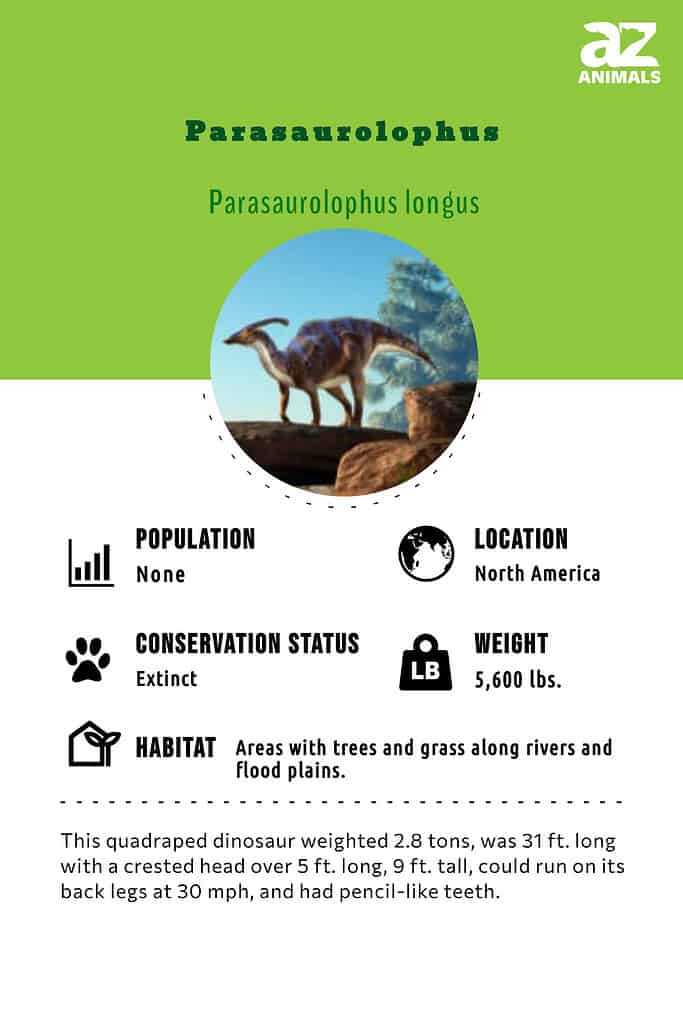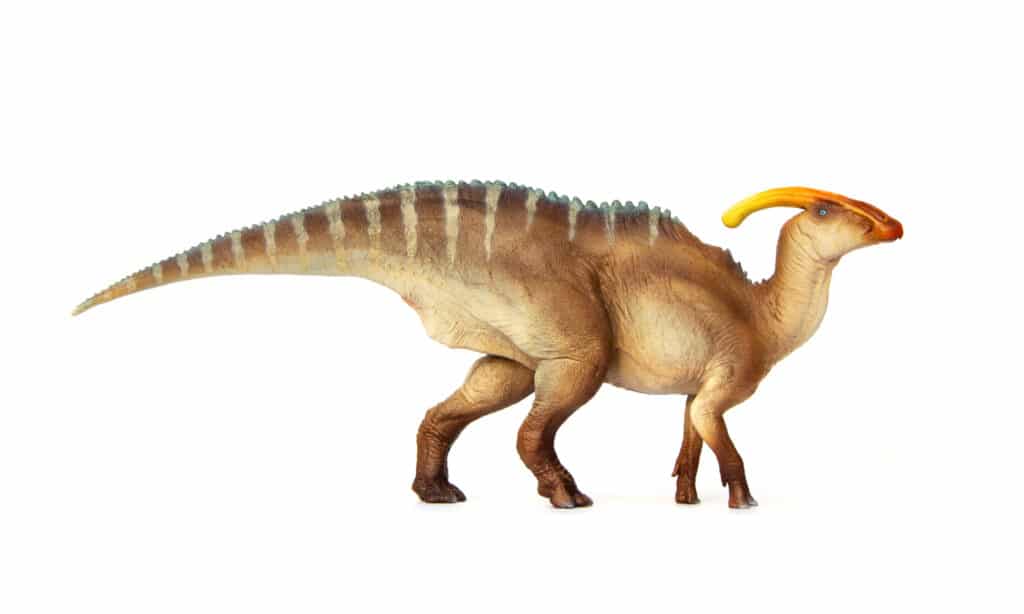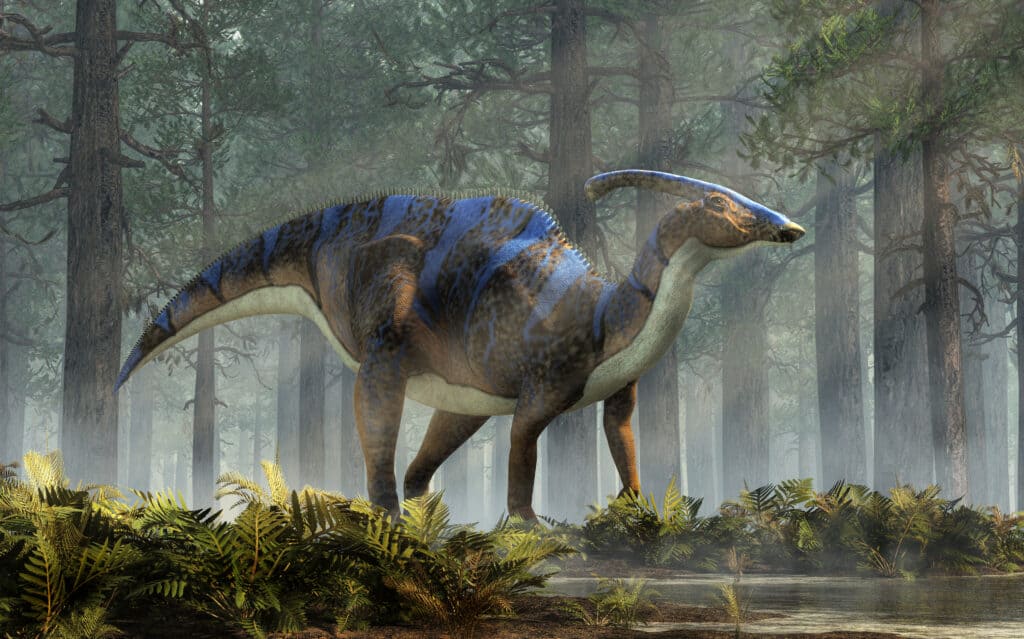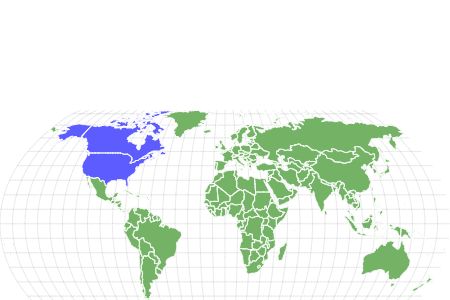Parasaurolophus
The Parasaurolophus ran on its hindlegs at speeds of up to 30mph!
Advertisement
Parasaurolophus Scientific Classification
Read our Complete Guide to Classification of Animals.
Parasaurolophus Conservation Status
Parasaurolophus Facts
- Fun Fact
- The Parasaurolophus ran on its hindlegs at speeds of up to 30mph!
- Most Distinctive Feature
- Cranial crest
- Diet
- Herbivore
View all of the Parasaurolophus images!
The Parasaurolophus ran on its hind legs at speeds of up to 30 miles per hour.

Classification and Scientific Name
The Parasaurolophus is a member of the Order Ornithischia, the Clade Ornithopoda, the Family Hadrosauridae, the Subfamily Lambeosaurinae, and the Tribe Parasaurolophini, all of which are extinct. This dinosaur lived in North America, and possibly Asia, from about 76.5 to73 million years ago in the Late Cretaceous Period.
Parasaurolophus walkeri is the scientific name of the type species of the genus Parasaurolophus. The Greek word Parasaurolophus means “near crested lizard.” It’s also called the duck-billed dinosaur because of its wide flat nose. The Parasaurolophus walkeri is one of three species (a fourth has been proposed but is currently listed in another genus). Its fossils were found in Alberta, Canada, The other two species are:
- Parasaurolophus tubicen (found in New Mexico; the largest species)
- Parasaurolophus cyrtocristatus (short-crested; the smallest species; found in New Mexico and Utah)
Description and Size

The Parasaurolophus is best known for its cranial crest and for its speed when running on two legs while carrying nearly 3 tons of weight!
©Ton Bangkeaw/Shutterstock.com
While the name of this dinosaur may not be immediately familiar, you’re very likely to recognize the Parasaurolophus in a drawing or painting. This dinosaur is best known for its cranial crest. That’s the long, hollow bone beginning at the tip of its nose, continuing up the middle of its face, and curving upward extending to an area behind its skull. Typically, males had larger crests than females.
Some paleontologists believe this dinosaur’s crest contained tubes that were connected to its nostrils. This idea gives way to a theory that the Parasaurolophus was able to make horn-like noises with the air flowing up through its crest. Some dinosaur scientists have even compared the inner design of this dinosaur’s crest to a snorkel.
Paleontologists think the Parasaurolophus was 31 feet long and weighed 2.8 tons (5,600 lbs.). The head of this dinosaur, including its long crest, was thought to measure 5 ft., 3 in. This dinosaur’s estimated height is 9 feet at the shoulders and much taller when standing on its hind legs.
When moving slowly along looking for food, the Parasaurolophus would lower its front legs to the ground to walk on all fours. When it ran, though, it ran with remarkable speed, up to 30 mph, on its two hind legs.
This dinosaur was a herbivore. So, instead of having long, sharp teeth like a carnivore, the Parasaurolophus had relatively short teeth made for grinding vegetation. Paleontologists believe these dinosaurs lost teeth on a regular basis, but a few lost teeth wasn’t a big deal to this dinosaur. It had hundreds in its mouth!
This dinosaur had either very short claws or no claws at all. So, it couldn’t use them as a defense against predators. However, this dinosaur had great vision, allowing it to monitor its surroundings for predators.
The Parasaurolophus had a long tail it could flatten out. It’s believed this animal used its long tail to propel itself through the water.
Diet

A parasaurolophus was a herbivore that ate leaves, grass, ferns, pine needles, and other vegetation.
©Daniel Eskridge/Shutterstock.com
As a herbivore, the teeth of the Parasaurolophus were made to grind and chew vegetation. So, what exactly did the Parasaurolophus eat? Leaves, grass, ferns, and pine needles were all part of the diet. Keep in mind these dinosaurs were nine feet tall and much taller when standing on their hind legs, so they were able to grab leaves and other vegetation high up in the trees. They used their shovel-like nose, or beak, to snip parts of vegetation away from branches.
Habitat
These dinosaurs lived in Canada and the United States. Its fossils have been found in Alberta, Canada, and in New Mexico and Utah. Some paleontologists believe this dinosaur lived in China also.
Not surprisingly, they lived in a habitat with plenty of trees, grass, and other vegetation in order to have a constant supply of food. This habitat would have had rivers and floodplains that became more swampy and influenced by marine conditions over time, which may have affected their food supply.
Threats and Predators
The Parasaurolophus was preyed upon by the Tyrannosaurus rex. T. rex dinosaurs were 38 feet long and weighed from 8,800 to 11,000 pounds. So, they were much larger than the Parasaurolophus. Also, though the T. rex was much slower moving than the Parasaurolophus, it was able to overpower this herbivorous dinosaur with its incredible strength.
The Albertosaurus was another predator of the Parasaurolophus. The Albertosaurus was about the same size or even a little longer than the Parasaurolophus.
The Daspletosaurus is another notable predator of the Parasaurolophus. Although strong, this carnivore was a little shorter than the Parasaurolophus at 27 to 30 feet long.
Paleontologists believe the Parasaurolophus lived in herds. This provided some protection from its large predators. The speed of the Parasaurolophus was another one of its defenses.
Discoveries and Fossils

Fossils of the Parasaurolophus were first discovered in Canada in 1922 and since then in New Mexico and Utah.
©YuRi Photolife/Shutterstock.com
The first discovery of Parasaurolophus bones occurred in Canada in 1922. Paleontologist William Parks discovered a Parasaurolophus skull as well as part of a skeleton in Alberta.
In 1961, bones of the Parasaurolophus were found in New Mexico in the Fruitland formation as well as in Utah in the Kaiparowits Formation.
Another major discovery of Parasaurolophus remains happened in southern Utah in 2009. The partial skeleton measured less than six feet long, which led paleontologists to believe the dinosaur was less than one year old. The remains of this Parasaurolophus are named Joe.
Extinction
Not surprisingly, paleontologists aren’t agreed on how the Parasaurolophus died out. But one common theory is an asteroid measuring six miles wide hit the earth sometime near the end of the Cretaceous Period. When the asteroid hit the earth, it caused a layer of dust to surround the planet. This layer of dust blocked a lot of sunlight from entering the earth’s atmosphere. Well, when plants and other vegetation don’t get enough sunlight, they die. Consequently, the Parasaurolophus along with other herbivorous dinosaurs lost their food source and slowly died off.
Paleontologists discovered a crater in Mexico with rocks they believe date back to the Cretaceous Period. This is where they think the asteroid hit the earth.
Similar Animals
Dinosaurs similar to the Parasaurolophus include:
- Saurolophus – The name Saurolophus sounds a lot like Parasaurolophus so it’s no surprise to say they look a lot alike too! Both have a crest atop the skull curving out behind the head. However, paleontologists believe that while the crest of a Parasaurolophus was hollow, the crest of a Saurolophus was made of solid bone.
- Amurosaurus – The Amurosaurus has a crest on its head, though it’s shorter than the Parasaurolophus’ crest. This dinosaur was a herbivore as well but was smaller than the Parasaurolophus at 25 feet long.
- Anatotitan – This dinosaur has a snout that looks like a duck’s bill similar to the Parasaurolophus. In fact, its Greek name means giant duck. At 40 feet long, the Anatotitan was a little longer than the Parasaurolophus.
Parasaurolophus FAQs (Frequently Asked Questions)
When was the Parasaurolophus alive?
The Parasaurolophus was alive during the Cretaceous period 74 to 76 million years ago.
How big was the Parasaurolophus?
The Parasaurolophus was believed to be 31 feet long with a weight of 2.8 tons. Its height is estimated at nine feet when standing on all four legs.
How do you pronounce Parasaurolophus?
Good question! The best way to pronounce this long dinosaur name is by doing it phonetically. When you say Parasaurolophus it sounds like you’re saying para-SORROW-low-fuss.
What were the predators of the Parasaurolophus?
One predator of the Parasaurolophus was the Tyrannosaurus rex. Though the T.rex wasn’t as fast as the Parasaurolophus, it was definitely bigger and stronger.
Another predator was the Daspletosaurus. It was stronger and could overpower this herbivorous dinosaur, too.
The Albertosaurus was a carnivorous predator that could pursue and take down a Parasaurolophus with its great strength.
What is special about the Parasaurolophus?
The most notable thing about the Parasaurolophus is its crest. This structure starts at the dinosaur’s nose, curves up the front of its skull, and arches back over its head. This dinosaur even has a dip in its back, so it doesn’t poke itself with the point of its crest when it moves its head backward!
What purpose did the Parasaurolophus’ crest serve?
The answer is: Paleontologists aren’t sure. But, of course, there are some theories about it. One theory is that there were tubes in the hollow crest of a Parasaurolophus. Air traveled from its lungs to its nose and through its crest allowing this creature to make horn-like noises. The theory goes on to suggest Parasaurolophus’s used these noises to communicate with one another.
A second theory is the crest helped to regulate the body temperature of this dinosaur. In short, the hollow nature of the dinosaur’s crest allowed more heat to evaporate from its body keeping it cool.
Another theory suggests that the appearance of the crest helped the Parasaurolophus to differentiate males from females in a herd. The male’s crest was usually larger than that of the females.
Which theory do you believe?
Hadrosaurus vs Parasaurolophus: Who Would Win in a Fight?
The Parasaurolophus would win a fight against Hadrosaurus. The truth is that these two dinosaurs were both herbivores. The chances of them fighting were very slim, even if they had lived at the same time and areas. Simply put, size would be the deciding factor here because the creatures would probably have to bash each other to death with kicks, stomps, or headbutts.
Saurolophus vs Parasaurolophus: What Are The Differences?
The biggest differences between a Saurolophus and a Parasaurolophus are their size and the era in which they lived.
Read about the other differences here!
Thank you for reading! Have some feedback for us? Contact the AZ Animals editorial team.
Sources
- Natural History Museum, Available here: https://www.nhm.ac.uk/discover/dino-directory/parasaurolophus.html
- NC State University, Available here: https://news.ncsu.edu/2021/02/parasaurolophus-skull-solves-mysteries/
- Wikipedia, Available here: https://en.wikipedia.org/wiki/Parasaurolophus
- CBC News, Available here: https://www.cbc.ca/news/canada/calgary/dino-of-the-week-parasaurolophus-1.3669495
- Smithsonian, Available here: https://www.si.edu/newsdesk/factsheets/tyrannosaurus-rex
- Sam Noble Museum, Available here: https://samnoblemuseum.ou.edu/understanding-extinction/mass-extinctions/end-cretaceous-extinction/
- American Museum of Natural History, Available here: https://www.amnh.org/exhibitions/dinosaurs-ancient-fossils/display-or-defense/fighting-or-flirting
- Philip J Currie Dinosaur Museum, Available here: https://dinomuseum.ca/2021/01/06/the-real-parasaurolophus/
- Morgridge Institute for Research, Available here: https://morgridge.org/blue-sky/how-did-dinosaurs-go-extinct/

















